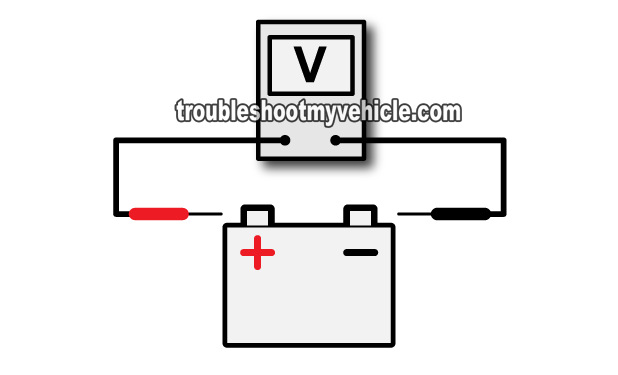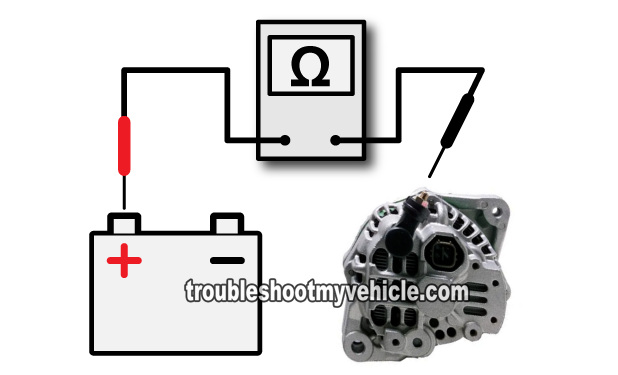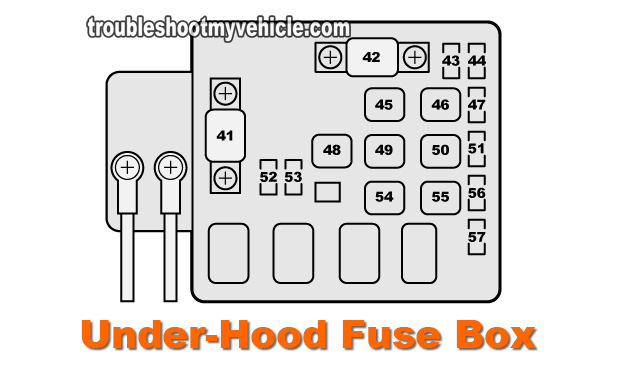
Testing the alternator in your 1.6L Honda Civic, to see if it is bad (or not), can be accurately done with just a multimeter.
Not only that, testing it is easy and fast and in this tutorial, I'll show you how.
Contents of this tutorial:
ES ![]() You can find this tutorial in Spanish here: Cómo Probar El Alternador (1996-2000 1.6L Honda Civic) (at: autotecnico-online.com).
You can find this tutorial in Spanish here: Cómo Probar El Alternador (1996-2000 1.6L Honda Civic) (at: autotecnico-online.com).
APPLIES TO: This tutorial applies to the following vehicles:
- 1.6L Honda Civic CX: 1995, 1996, 1997, 1998, 1999, 2000.
- 1.6L Honda Civic DX: 1995, 1996, 1997, 1998, 1999, 2000.
- 1.6L Honda Civic EX: 1995, 1996, 1997, 1998, 1999, 2000.
- 1.6L Honda Civic LX: 1995, 1996, 1997, 1998, 1999, 2000.
Symptoms Of A Bad Alternator
Since the alternator provides the electrical current that your Civic needs once it starts and charges the battery so that it's ready to crank the car the next time so when it fails, you'll notice one or several of the following symptoms:
- Charge light On: The charge light (or battery light) is shining nice and bright on your dashboard, letting you know there's a problem with the charging system.
- Dim headlights: When driving at night, the headlights seem unusually dim, a clear sign that the alternator isn't supplying enough power.
- Won't crank but starts with a jump: The engine won't crank on its own, but with a jump-start, your Honda starts up without any issues.
- Battery keeps dying: The battery constantly needs recharging or jump-starting. Even after starting, the vehicle only runs briefly before stalling.
- Lights flicker or dim intermittently: The headlights or interior lights fluctuate in brightness while driving, pointing to irregular alternator output.
- Unusual noises: A failing alternator might produce a whining or grinding sound due to worn bearings or internal components.
- Weak or dead battery: The battery becomes weak or drains completely, even if it's been replaced or charged recently.
Where To Buy A Brand New Alternator
You can buy a brand new alternator for what it will cost you to buy a rebuilt one at your local auto parts store.
Check out the links below and shop/compare and see for yourself:
Disclosure: As an Amazon Associate, I earn from qualifying purchases. If my tutorials help you, using these links is an easy way to support the site at no extra cost to you. Thank you!
Not sure if the above alternator and alternator belt fit you particular 1.6L Honda Civic? Don't worry, once you get to the site, they'll make sure the parts fit and if they don't they'll ask you about your Civic's specifics to find you the right parts.
TEST 1: Battery Voltage Test With Engine Running

This very first test will confirm that the alternator is either not working and thus not charging the battery or it is working and thus charging the battery.
We'll do this by simply checking the battery's voltage with your Civic's engine running and your multimeter set to Volts DC mode.
NOTE: For this test to be effective, the battery has to have enough of a charge to keep your Civic running for at least 5 to 10 minutes. So, if the battery is completely dead, charge it up.
These are the test steps:
- 1
Crank and start your Honda Civic.
- 2
Select Volts DC mode on your multimeter.
- 3
Connect the red multimeter test lead to the positive (+) battery terminal.
- 4
Connect the black multimeter test lead to the negative (-) battery terminal.
- 5
Your multimeter is gonna' register one of two possible readings:
1.) A steady 13.5 to 14.5 Volts DC.
2.) Or 12.5 Volts that will decrease the longer the engine stays running. - 6
Put an electrical load on the alternator to further confirm that it's either charging or not charging.
This can be very easily done by turning on every accessory possible (inside the vehicle). Turn on the A/C or heater on high, turn on the windshield wipers, turn on the headlights, turn on everything and anything that uses electricity inside and outside of the vehicle. - 7
Your multimeter will show you one of two things (as you turn on all of this stuff):
1.) The multimeter will register a nice and steady 13.5 to 14.5 Volts DC no matter what gets turned on.
2.) It will register 12.5 Volts DC and this voltage will decrease more and more as you turn on stuff inside your Honda vehicle.
OK, let's interpret your multimeter test results:
CASE 1: Your multimeter registered 13.5 to 14.5 Volts. This is good and it tells you that the alternator is working and is charging the battery and providing enough juice for the electrical needs of your Honda Civic.
No further testing is required, since this multimeter test result eliminates the alternator on your Honda Civic as bad.
CASE 2: Your multimeter registered a voltage that steadily dropped down to 9 Volts. This is a clear indication that your Honda Civic's alternator IS NOT charging the battery.
Replacing the alternator at this point usually solves around 90% of the no-charge conditions on any 1.6L Honda Civic around the world. That's right, you could stop testing here and say: 'The alternator is fried' and be done.
But I suggest two more easy tests to be absolutely sure the alternator is bad. For the first test of the two, go to: TEST 2: Checking The Continuity Of The Bat (+) Cable.
TEST 2: Checking The Continuity Of The Bat (+) Cable
All of the electrical power that the alternator produces, to charge the battery and to power any of your Honda Civic's electrical needs, passes thru' a single 80 Amp mega fuse!
This 80 Amp mega fuse is located in the under-hood fuse/relay box and if it's blown then the alternator could be working, but its output will never reach your Honda Civic's battery (this mega fuse is labeled with the #42 in the second illustration in the image viewer).
So in this test step, you're going to verify that this fuse is OK on your 1.6L Honda Civic before we proceed with the next and last test (which is checking the alternator fuse in the under-dash fuse/relay box inside your Civic).
This is what you'll need to do:
- 1
Disconnect the battery negative (-) cable terminal from the battery negative (-) post. The positive cable remains connected.
IMPORTANT: Don't continue to the next step without first disconnecting the negative cable from the negative battery post. - 2
Set your multimeter to Ohms mode.
- 3
Connect the red multimeter test lead to the stud on the rear of the alternator. The BAT + cable, which connects to the battery positive (+) terminal, is the cable that connects here.
The arrow in the photo points to this stud. - 4
With the black multimeter test lead probe the center of the battery positive (+) post on your Honda Civic's battery.
- 5
You'll get one of two results.
1.) If the 80 Amp mega fuse, protecting this circuit, is blown then your multimeter will indicate a reading of OL (which means over limit). In other words, there will be NO continuity.
2.) If the 80 amp mega fuse is OK and not blown, your multimeter will register an Ohms reading of 0.5 Ohms or less. In other words, there will be continuity.
Let's take a look at what your results mean:
CASE 1: Your multimeter registered continuity. This is good, since it indicates that the 80 amp mega-fuse protecting this circuit is OK and not blown.
The last test to do also involves checking the condition of another fuse. Except that this is just a regular plastic blade type fuse found in the fuse box under the dash. For this test, go to: TEST 3: Checking The Alternator Fuse.
CASE 2: Your multimeter DID NOT register continuity. This result tells you that the 80 amp mega fuse is blown and this will keep the alternator from charging the battery.
This fuse is locate in the under-hood fuse box and is labeled with the number 41 in image 2 of 2 in the image viewer above.
Replace the fuse and retest. Replacing the 80 amp mega fuse (if it's blown) should solve your No Charge condition. You'll have to investigate the reason this mega fuse blew, since they don't get blown for no particular reason.
TEST 3: Checking The Alternator Fuse

There's one more fuse that you need to check, before condemning the alternator as fried on your 1.6L Honda Civic.
This is the alternator fuse of the under-dash fuse/relay box. This fuse is the number 15 fuse and this bad boy is a 7.5 amp fuse.
The illustration in the image viewer (of the under-dash fuse/relay box) will help you locate this alternator fuse on your 1996-2000 1.6L Honda Civic.
NOTE: You can enlarge the image in the image viewer to get a good view of the location of the number 15 fuse.
This is what you need to do:
- 1
Reconnect the battery to its battery negative (-) cable, that you disconnected in the previous test.
- 2
Locate the alternator fuse, which will be located in the under-dash fuse/relay box inside your Honda Civic.
The alternator fuse of the under-dash fuse/relay box is the number 15 fuse. - 3
Once you have located the alternator fuse, remove it and check that it's not blown.
- 4
If it is blown, replace it with a new one and repeat TEST 1.
Let's examine your test result:
CASE 1: The alternator fuse is NOT blown. This is good and let's you know that the alternator has all of the power sources it needs to charge, since it isn't then this result also let's you know that the alternator is bad and needs to be replaced.
CASE 2: The alternator fuse IS blown. Replace the fuse with another of the same amperage rating (7.5 amps) and start the car and check to see if the alternator is now charging the battery by repeating TEST 1.
More 1.6L Honda Civic Test Articles
If this tutorial helped then you might be interested in the others found here:
Here's a sample of the articles you'll find in the index:
- How To Test Trouble Code P0135 (1995-2000 Honda 1.6L).
- How To Test: Lock-up Control Solenoid Valves (1996-2000 1.6L Honda Civic).
- How To Troubleshoot A No Start (1995-2000 1.6L Honda Civic).
- How To Test The Igniter, Ignition Coil Accord, Civic, CRV, and Odyssey (at: easyautodiagnostics.com).

If this info saved the day, buy me a beer!







